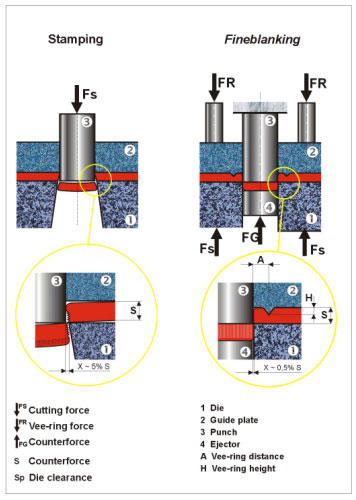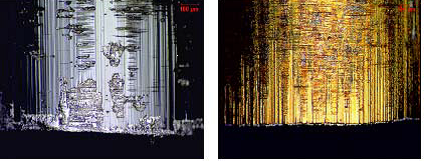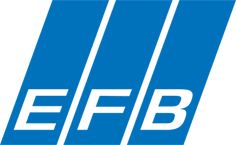Brief introduction into the blanking process
The process of cutting or stamping with a single punch uses a free blank holder. The process of fine blanking instead uses a compressed blank holder and counter forced ejector. In both cases, the punch movement draws the sheet metal over the cutting edge with a constant force Fs. The result of the cut is also shown: the die clearance in case of normal cutting is rather high. This generates an edge burr with a curved fracture surface; the borders of the punched hole and the sheet are not flat but deformed.
These burrs and deformation at the hole and the sheet does not appear when using a compression on the blank holder as in case of fine blanking. Here the blank holder consists of a guide plate equipped with beads or stingers (comparable to deep drawing beads) which is pressed against the sheet with a constant force FR. The clearance is also smaller than traditional stamping. The pressure and draw beads prevent the deformation of the sheet borders during punching. This action results in a nice and flat hole without burrs.

Differences between cutting and fine blanking
The high mechanical loads in fine blanking operations lead to increased wear of the tools, especially the punch. With increasing sheet thickness and strength of the sheet material the wear increases and therefore economic production often is impossible. Significant improvements of wear reduction have been achieved already by using titanium-based hard coatings. TiN, TiCN and TiAlN coatings are now state of the art in the coating of fine blanking tools for steel processing.

Wear marks on coated fine blanking punches, left aC:H:W-coated, right TiN coated
The coatings studied in this project will be applied by the using mainly PVD deposition techniques. With these techniques, it is possible to combine the tribological function of coatings with the properties of the tool substrate, to create improved mechanical properties. In addition to the tribological function, these coatings increase the superficial hardness of the tool and reduce wear in a significant way.
In some cases, tools without coatings can be tolerated. However, the ever increasing production rate and the use of high strength steel sheet can induce problems in the wear and fracture behavior of working tools with low lifetimes as a consequence.
Little is known about the tribological synergy of the combinations: coating-heat/cold treatment-substrate and their influence on life-time in heavy load conditions. It is also important to study how good cutting edges are achieved with these special coatings and materials and how the tools respond to the working conditions of the machine or process.
Partner of the INFIBLANK Project
Objectives and Work Packages in the INFIBLANK project
Results

